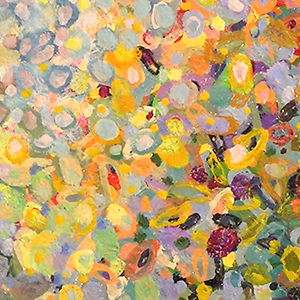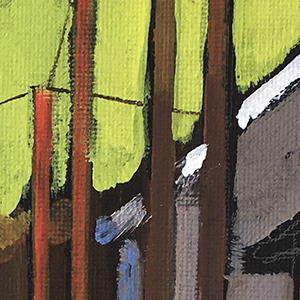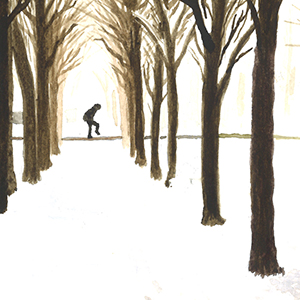These days, it feels hard to have hope. From climate change, global conflict, and the lingering effects of a deadly pandemic to the persistence of political division, economic uncertainty, and various forms of injustice, there are significant reasons to feel pessimistic, and many Americans do. Polls report increased pessimism among Americans, especially among young people, who report higher levels of mental health challenges, job insecurity, and financial instability.1
For university educators, these trends are especially concerning given the dangers of despair and the benefits of hope. Numerous studies, including many involving college students, show that those with higher levels of hope tend to express a greater sense of meaning in life, lower levels of anxiety and depression, more productivity, and increased academic achievement.2 Hope is essential to flourishing.
For these reasons, Sian Beilock, President of Dartmouth College, has suggested that colleges and universities have “a role in cultivating hopefulness.”3 Contributors to this issue of Virtues & Vocations agree. As a scholar of hope who leads the Program for Leadership and Character at Wake Forest University, I want to explore what kind of hope we should cultivate and how we can educate it effectively within colleges and universities.
The Virtue of Hope
Today, most of us consider hope to be a feeling or emotion, a desire for some future good that we believe to be possible to attain. Certainly, hope is a such feeling, one that often has positive effects. But as a feeling, hope is not always good or appropriate. We can, after all, hope for objects that are neither good for us nor possible to attain, and we can hope for genuine goods in ways that assume more certainty than is warranted. Moreover, as a mere feeling, hope is hardly stable or sustaining. Like other emotions, it can ebb and flow with the vicissitudes of fortune and circumstance. We need some way to stabilize, regulate, and guide our feelings of hope toward appropriate objects in the appropriate ways.
Here is where the virtue tradition can help. It includes a long history of conceptualizing hope as a virtue, a reliable and stable disposition of character that enables us to direct our desire for future goods toward appropriate objects in appropriate ways that lead to human flourishing.4
Understanding hope as a virtue offers four advantages for educating hope in higher education. First, developing the virtue of hope requires distinguishing appropriate objects of hope from inappropriate ones and even recognizing that the feeling of hope might not always be the appropriate response. This is one way in which the virtue of hope differs from optimism and positive thinking, which tend to encourage a generalized positive attitude and confident expectation about all outcomes rather than a wise assessment of particular objects and the risks involved in pursuing them.
Second, and relatedly, the virtue tradition recognizes that virtues are accompanied by corresponding vices. The vices typically opposed to hope are presumption, in which one’s hope is excessive or misplaced, and despair, in which one’s hope is absent or insufficient. Developing the virtue of hope requires resisting temptations toward both presumption and despair.
Third, the virtue tradition emphasizes the “interconnection” of the virtues, the idea that the development and exercise of any one virtue relies on the support of other virtues. The virtue of hope, for example, relies on practical wisdom to discern hope’s proper objects and the best means to achieving them, humility to recognize our limitations and chasten presumption, and gratitude to acknowledge others’ support and resist despair. Educating the virtue of hope requires supporting the development of these and other virtues.
Fourth, the virtue tradition views virtues as acquired and dynamic rather than inherited and static. Since virtues are understood as habits or dispositions of character, they must be developed and sustained over time through intentional practice. As a result, the virtue tradition includes pedagogical practices and strategies that can aid in educating the virtue of hope.
Seven Strategies for Educating Hope
How can colleges and universities cultivate hope?
Over the last few years, colleagues from the Oxford Character Project and I have identified seven strategies for educating virtues of character based on research across multiple fields.5 At Oxford and Wake Forest, we have integrated these strategies in curricular and co-curricular contexts with undergraduate students as well as graduate and professional students. Empirical studies affirm that these strategies have been effective in developing virtues of character.6 Drawing on examples from “Commencing Character”––an undergraduate seminar that integrates these seven strategies with the study of virtue theory and contemporary commencement speeches––I want to illustrate how such strategies might help to cultivate the virtue of hope.
1. Habituation through Practice
To develop hope as a stable virtue of character, we must habituate it, much like a skill, by practicing the right kind of hope over and over again until it becomes a settled habit. As Krista Tippett suggests, hope is like a “muscle” that strengthens the more we use it.7 As in weight training, its practice can stretch and strain us but, ultimately, can help us grow stronger.
One way to encourage students to habituate hope is ask them to practice it over several weeks. In “Commencing Character,” I ask students to choose a virtue they wish to strengthen and then to analyze its conceptual structure, develop a plan to cultivate it, and apply that plan over two weeks before reflecting on what they learned. Some students focus on hope, integrating practices that help them reflect concretely on their hopes and recognize when they are tempted toward presumption and despair. One self-proclaimed “pessimist” discussed how the process transformed her perspective and bolstered her agency. Even in the face of an unexpected setback, she realized that, even when she didn’t feel very hopeful, she could still “choose hope.”
2. Reflection on Personal Experience
The process of habituating hope benefits from a second strategy: reflection on personal experience. We cannot develop the virtue of hope merely by applying an abstract formula, listening to a lecture, or reading a book. We must learn, in part, through experience—by reflecting on times when hope empowered us to achieve a difficult good or when presumption or despair prevented us from realizing our goals. Reflecting on experience can hone the virtue of practical wisdom, which is needed to determine how to hope in the right ways at the right times.
As educators, we can encourage reflection in various ways, whether through individual journaling or group discussion. In my class, I ask students to reflect individually on personal strategies that help them sustain hope in the face of difficulty and then share them on a pre-class discussion board. This reflection not only primes a deeper discussion of hope in class, but also helps students see their lived experience as a valid source of knowledge and elevates their classmates as potential exemplars of hope, which connects to a third strategy.
3. Engagement with Virtuous Exemplars
Many philosophical and religious traditions highlight the role of moral exemplars or role models as essential to moral formation. By embodying what a particular virtue or ideal looks like in practice, exemplars can deepen our understanding of a virtue, inspire us to develop it, and provide a model to emulate.
To introduce exemplars of hope, we might highlight role models from the “history of hope,” showing how leaders of social movements—from abolitionism and women’s suffrage to civil rights––have embodied hope in the face of fear and despair.8 Or we might introduce students to role models in our contemporary context. For example, I assign commencement speeches by Chimamanda Ngozi Adichie, Barbara Kingsolver, Maria Popova, and Bryan Stevenson, all of whom emphasize and embody hope in our contemporary context.
Exemplars, however, do not need to be famous to be effective. In fact, research suggests that “relevant” and “attainable” exemplars often influence character development more powerfully than historical or heroic exemplars.9 To build on this insight in class, I assign a “Profile in Character” that invites students to interview a relevant and attainable exemplar in their lives and then write a profile of their character. A number emphasize their exemplar’s hope. Such examples—whether famous or familiar—can provide evidence that achieving specific objects of hope might also be possible for us.
4. Dialogue That Increases Virtue Literacy
One aid to developing a virtue is understanding what it is (and what it is not). Knowing what the concept involves, how the virtue differs from its semblances and corresponding vices, and how related virtues support it can inform how we acquire and exercise the virtue.
Such virtue literacy is especially valuable for hope. For example, knowing that the virtue of hope is not the same as optimism can free us from the belief that we must always maintain a positive attitude to exercise hope. Sometimes optimism can blind us to real obstacles or cause us to believe an outcome is more likely than it actually is, which can express the vice of presumption more than the virtue of hope.
Hope literacy can be taught in various ways. For example, we might assign readings that discuss the complexities of hope and consider its relevance to contemporary challenges before engaging students in a discussion of hope, its opposing vices, and related virtues that can help us overcome challenges to it. Course assessments show that students’ understanding of the virtue often shifts significantly as a result of such readings and discussions.
5. Awareness of Situational Variables
Among the obstacles to developing and exercising virtue are the unconscious biases and situational variables that shape our thoughts, feelings, and behaviors in ways we might not consciously realize. Over the last few years, educators have recommended “getting the word out” about such influences so we can recognize, correct, and counteract them.10
Two of the most relevant to hope are the optimism and pessimism biases. According to Tali Sharot, “optimism bias” refers to “the inclination to overestimate the likelihood of encountering positive events in the future and to underestimate the likelihood of experiencing negative events.”11 Sharot traces the sources and effects of this bias, which is common across race, class, and age, including in college students.12 While a bias toward optimism can lead to positive outcomes, it also has potential perils, sometimes causing us to become overconfident or neglect risks.
If optimism bias can encourage presumption, pessimism bias can induce despair, causing us to assume that negative events are more likely than they might actually be.13 While less common than optimism bias, pessimism bias can cause us to doubt our capacities or underestimate the possibility of positive outcomes.
Perspective-taking exercises can help students recognize the influence of these and other biases and avoid their worst effects. Those inclined toward optimism bias, for example, may benefit from intentionally trying to imagine possible obstacles, while those inclined toward pessimism bias may benefit from envisioning potential positive outcomes in vivid detail or brainstorming multiple pathways to achieve their goals.14 Inviting students to participate in such prospection—whether in a journal, class discussion, or group project—can nurture hope.
6. Moral Reminders
In light of these biases and influences, we can also use moral reminders to make specific objects of hope more salient, especially when we might be tempted toward presumption or despair. Moral reminders call aspirations and commitments to mind and encourage us to think, feel, and act in line with them.
In relation to hope, for example, students might memorize a quote or mantra to recall in a challenging time, put the image of a hopeful exemplar on their wall, or write a letter to themselves about their aspirations and read it a year later to evaluate their efforts. As Shane Lopez suggests, such small reminders can provide cues that “trigger” action and supply inspiration, motivation, and accountability in times of difficulty.15
Students might also use moral reminders to cultivate hope indirectly. For example, writing gratitude letters or keeping a gratitude journal has been shown to support the virtue of gratitude, which can bolster both hope and humility.16 If we remember who and what we are grateful for, we may be less likely to focus only on negative outcomes and more likely to acknowledge those who have assisted us, which can prevent despair. Meanwhile, remembering that we did not achieve progress on our own can foster humility and prevent presumption. The self-proclaimed “pessimist” who attempted to habituate hope in my class reported that keeping a gratitude journal was one of her most helpful practices. She felt more hopeful because she was more grateful.
7. Friendships of Mutual Accountability
The relationship between gratitude and hope points to another aspect of character development: virtues are nurtured through friendships of mutual support and accountability. Relying on others’ assistance is especially important for the virtue of hope. While discussions of hope typically focus on what we hope for, Augustine and Aquinas remind us that achieving objects of hope also depends, in part, on whom we hope in.17 This is why Aquinas says that hope’s twofold object includes both “the good which it intends to obtain, and the help by which that good is obtained.”18
Friends often provide such help. “[T]hough it is not for one’s own benefit,” Aquinas writes, “friendship . . . has of course many resulting benefits, in the sense that one friend helps another as he helps himself. Hence, when one person loves another, and knows that he is loved by that other, he must get hope from him.”19
In addition to providing assistance, friends can also help us resist presumption and despair. Friends can provide correction and accountability when we are tempted toward presumption, reminding us of our limits and helping us to recalibrate or redirect our hopes. And they can offer care and support when we are tempted to despair.20 As a result, helping students develop meaningful friendships—for example, by designing classes, cohorts, or assignments to facilitate relationships or setting up structures for peer mentoring or accountability—may be among the best ways to nurture hope.
This mutuality of such relationships points to a final way to educate hope in our students: by educating hope in ourselves. As Parker Palmer argues in The Courage to Teach, “good teaching cannot be reduced to technique; good teaching comes from the identity and integrity of the teacher.”21 If we aspire to be virtuous exemplars and develop authentic relationships with our students, it is important for us to do the difficult inner work that we expect of them. Otherwise, any techniques or strategies, no matter how effective, will only go so far. Given our influence as educators in a moment when despair may be especially tempting, educating hope within ourselves may be one of our most urgent tasks.
Notes
- See, e.g., Megan Brenan, “Americans Largely Pessimistic about U.S. Prospects in 2023,” Gallup, January 3, 2023, news.gallup.com/poll/467528/americans-largely-pessimistic-prospects-2023.aspx; Jack Beresford, “How America Lost Its Optimism,” Newsweek, February 2, 2023, newsweek.com/america-optimism-future-poll-pandemic-ukraine-culture-wars-1778469; André Dua, Kweilin Ellingrud, Michael Lazar, Ryan Luby, and Sarah Pemberton, “How Does Gen Z See Its Place in the Working World? With Trepidation,” McKinsey.com, October 19, 2022, mckinsey.com/featured-insights/sustainable-inclusive-growth/future-of-america/how-does-gen-z-see-its-place-in-the-working-world-with-trepidation?cid=other-eml-mtg-mip-mck&hlkid=b3b67a241e374cea9f826afe0af10f40&hctky=1926&hdpid=d16fd902-1a9a-476d-9a61-71983b7bedff; Andrew Daniller, “Americans Take a Dim View of the Nation’s Future, Look More Positively at the Past,” Pew Research Center, April 24, 2023, pewresearch.org/short-reads/2023/04/24/americans-take-a-dim-view-of-the-nations-future-look-more-positively-at-the-past.
- For summaries, see Kirsten Weir, “Mission Impossible,” Monitor on Psychology, 44, no. 9 (October 2013): 42; Shane J. Lopez, Making Hope Happen: Create the Future You Want for Yourself and Others (New York: Atria, 2013), 50–62.
- Sian Beilock, “The Kids Aren’t Alright—but Hope Can Help,” Inside Higher Ed, February 22, 2023.
- On hope as a virtue, see, e.g., Michael Lamb, A Commonwealth of Hope: Augustine’s Political Thought (Princeton, NJ: Princeton University Press, 2022); Michael Lamb, “Aquinas and the Virtues of Hope: Theological and Democratic,” Journal of Religious Ethics, 44, no. 2 (June 2016): 300–332; Michael Lamb, “A Passion and Its Virtue: Aquinas on Hope and Magnanimity,” in Hope, ed., Ingolf U. Dalferth and Marlene A. Block (Tübingen: Mohr Siebeck, 2016), 67–88.
- For a fuller explanation of these strategies and the research that supports them, see Michael Lamb, Jonathan Brant, and Edward Brooks, “Seven Strategies for Cultivating Virtue in the University,” in Cultivating Virtue in the University, eds. Jonathan Brant, Edward Brooks, and Michael Lamb (New York: Oxford University Press, 2022), 115–156.
- Michael Lamb, Elise M. Dykhuis, Sara E. Mendonça, and Eranda Jayawickreme, “Commencing Character: A Case Study of Character Development in College,” Journal of Moral Education, 51, no. 2 (2022): 238–260; Jonathan Brant, Michael Lamb, Emily Burdett, and Edward Brooks, “Cultivating Virtue in Postgraduates: An Empirical Study of the Oxford Global Leadership Initiative,” Journal of Moral Education, 49, no. 4 (2020): 415–435.
- Krista Tippett, “On Hope,” Orion (Spring 2020), orionmagazine.org/article/on-hope.
- James W. Fraser, A History of Hope: When Americans Have Dared to Dream of a Better Future (New York: Palgrave Macmillan, 2004).
- Hyemin Han, Jeongmin Kim, Changwoo Jeong, and Geoffrey L. Cohen, “Attainable and Relevant Moral Exemplars Are More Effective than Extraordinary Exemplars in Promoting Voluntary Service Engagement,” Frontiers in Psychology 8, no. 283 (2017): 1–14.
- Christian Miller, The Character Gap: How Good Are We? (New York: Oxford University Press, 2018), 209–214.
- Tali Sharot, The Optimism Bias: A Tour of the Irrationally Positive Brain (New York: Vintage, 2012), xv.
- Sharot, Optimism Bias, xiv; Neil D. Weinstein, “Unrealistic Optimism about Susceptibility to Health Problems,” Journal of Behavioral Medicine, 5 (1982): 441–460.
- The Decision Lab, “Why Do We Think We Are Destined to Fail?,” accessed June 6, 2023, thedecisionlab.com/biases/pessimism-bias.
- See, e.g., Daniel Kahneman, Thinking Fast and Slow (New York: Farrar, Straus and Giroux, 2011), 264–265; Lopez, Making Hope Happen, 33–44, 125–142, 159–175.
- See Lopez, Making Hope Happen, 140, 143–158.
- See, e.g., Robert A. Emmons, Thanks!: How the New Science of Gratitude Can Make Your Happier (New York: Houghton Mifflin, 2007); Charlotte vanOyen Witvliet, Fallon Ritchie, Lindsey M. Root Luna, and Daryl R. Van Tongeren, “Gratitude Predicts Hope and Happiness: A Two-Study Assessment of Traits and States,” Journal of Positive Psychology 14, no. 3 (2019): 271–282; Elliott Kruse, Joseph Chancellor, Peter M. Ruberton, Sonja Lyubomirksy, “An Upward Spiral Between Gratitude and Humility,” Social Psychological and Personality Science 5, no. 7 (2014): 805–814.
- See Lamb, Commonwealth of Hope, 99–113; Lamb, “Aquinas and the Virtues of Hope.”
- Thomas Aquinas, Summa Theologica, trans. Fathers of the English Dominican.
- Province (New York: Benziger Brothers, 1948), II–II.17.4.
- Thomas Aquinas, Summa Contra Gentiles, Book 3, Part II, trans. Vernon J. Bourke (Notre Dame, Ind.: Notre Dame University Press. 1975), III.153.
- See, e.g., Lopez, Making Hope Happen, 169–171, 203–215.
- Parker J. Palmer, The Courage to Teach: Exploring the Inner Landscape of a Teacher’s Life (San Francisco, CA: Jossey-Bass, 2017), 10 (italics removed).





















